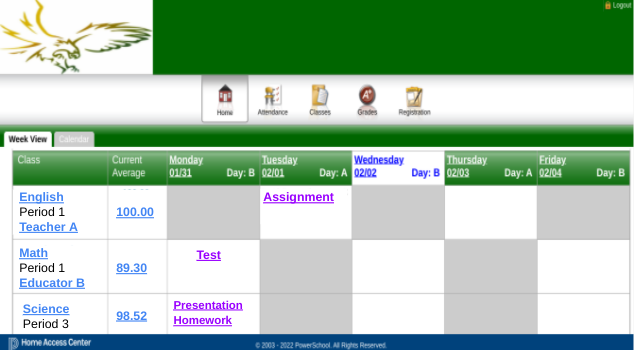Compulsive grade checking
A look into the pros and cons of the gradebook.
Sample home access center.
A student sits anxiously in their seat before class begins. Their classmates are still arriving so they decide to take a moment to check their grades. They get past the login screen only to discover- oh, the humanity.
They sit there aghast because they have just discovered that their grade has gone down. The teacher must have put the test grades in. This student has studied but they didn’t receive the A that they had longed for. Instead, they barely passed. This has resulted in their grades slipping out of the upper As and landing in the upper Bs where it now viciously mocks the student as an 89.3 percent.
The current semester is almost over. They have already turned everything in and they have no missing assignments. What will they do? Will there be homework? Will it be graded? What about extra credit? Will it round up by some miracle? What if their parents find out?
The Home Access Center (HAC), which is also referred to as the gradebook, is a resource that is available for every student attending GlenOak. The gradebook is helpful in many ways but it can also perpetuate harmful habits.
The students of GlenOak High School vary from avid grade-checkers to people who avoid checking their grades out of fear and/or indifference.
Madison Donnelly is a senior at GlenOak. She checks her grades twice everyday.
“I think for some people it becomes a compulsion, they check constantly and react negatively to the slightest change, I think that’s a small percentage though, being able to access your grades anytime is generally a very good thing,” Donnelly said.
The constant pressure from their teachers and family members can cause students to hyperfixate on their grades. They may not see the harm in it at the time but the stress can add up and lead to problems like waiting for changes or trying to negotiate their grades with teachers. The constant grade checking can be a symptom of the overwhelming expectation for students to be perfect.
Senior Malaina Crowl checks her grades once every few weeks to check the scores for tests and important assignments.
“One major downside I have seen some people fall victim to is the need to check their grades constantly. Some people are obsessed with their grades and I something think that some people would be less stressed if they only got a traditional report card at the end of the grading period. Overall I think the benefits outweigh the negatives though,” Crowl said.
The gradebook has many useful features. The most important feature is allowing students to view their grades for each of their classes. There is also a percentage breakdown which will show students how they did on individual assignments.
The gradebook gives students the opportunity to look at their schedule, keep track of their attendance and see whether it is an A day or a B day. It is helpful to have features such as these and many more centralized in one place for students to look. The gradebook has many helpful features but it can still be improved.
“The biggest thing I wish that they would add is a sort of academic history. I wish I was able to look back at previous years and see what grades I got each nine weeks,” Crowl said. “What bugs me the most is that we aren’t able to view our GPA for most of the year. If they could just include our most recent GPA from the last grading period it would really help me to keep track of it.”
There are also improvements that can be made to help the teachers who enter the grades. Alyssia Kobasic teaches Honors Algebra 2 and IB Maths Applications and Interpretations SL Year 1 and Year 2 at GlenOak high school.
“From a teacher’s perspective, I wish there was a way that I could see the student version of HAC. I have noticed differences in the interface of the student’s view compared to the teacher’s view on HAC,” Kobasic said.
Despite its flaws the gradebook is helpful overall for students.
“I like to keep up to date on how I’m doing in all my classes so I know how well I need to do on future assignments, it motivates me. I always know what’s going on and if there’s a problem it can be addressed right away. If I need to see if I have missing assignments or check on how I did on a test I am able to without having to ask someone at the school,” Donnelly said.
Being able to see what assignments are missing is very helpful for students but it can lead to some problems for teachers. Some students may attempt to negotiate the grades they have with their teachers.
“I feel many students ask if they can do extra credit to raise their grade. Also, near the end of the nine weeks students ask if they can turn in late work or do test corrections/retakes as a last ditch effort to raise their grade,” Kobosic said. “The gradebook can also be abused if students wait until the last week of the marking period to scramble and try to do something to change their grades. Proper planning and completion of assignments on time should not result in a last minute scramble.”
Theresa Rhoads is a counselor and academic advisor at GlenOak High School.
“I think that one of the biggest things I see in my role is that students have to remember that it takes time for the teachers to put those grades in the gradebook. So a lot of kids will come in and say “I turned this in and it’s not in there and it’s stressing me out” but it’s only been a day. It takes a lot of time for a teacher to grade 150 assignments and put them in the gradebook,” Rhoads said.
Students may become stressed when waiting to receive their grades. That stress could be alleviated by considering the teacher’s perspective.
“As a teacher, make-up work and late work are not on “the top of my pile” when it comes to grading. I begin with work that is turned in on-time first,” Kobasic said, “Oftentimes I receive emails about how a late homework assignment grade has not been entered in the gradebook yet; however, I just received the missing assignment that same day. This can be exasperating at times. Fear not, it will be entered, just maybe not the same day.”
Despite all of the issues that gradebook has it is still an improvement from previous ways that students kept track of their grades.
“When I was in school we had to write everything down. If I got a paper back from a teacher I wrote down the grades so that I could keep track and do the math of how I was doing in the class. Having it electronically and updated on a regular basis I think is really beneficial so that students know where they are as far as the class goes,” Rhoads said.
The gradebook has its problems but overall it is a useful resource for the students of GlenOak. Having access to their grades allows students to keep track of their grades and achieve their ideal grade.
“First, a phrase comes to mind: “Proper planning leads to success.” For the student that is conscious about his/her grades, it gives them the opportunity to properly plan in order to reach their goal,” Kobasic said. “If a student uses this tool as an aid to assist in reaching their goals I think the gradebook is a great tool.”
Click the link below to check your grades. https://hac.sparcc.org/HomeAccess/Account/LogOn?ReturnUrl=%2fhomeaccess
Your donation will support the student journalists of GlenOak High School. Your contribution will allow us to purchase equipment and cover our annual website hosting costs.






